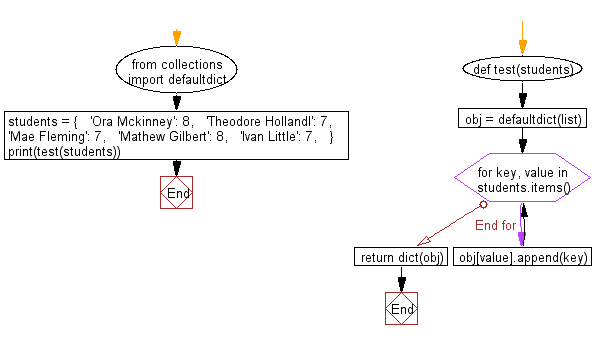Python: Invert a given dictionary with non-unique hashable values
67. Invert Dictionary with Non-Unique Values
Write a Python program to invert a given dictionary with non-unique hashable values.
- Create a collections.defaultdict with list as the default value for each key.
- Use dictionary.items() in combination with a loop to map the values of the dictionary to keys using dict.append().
- Use dict() to convert the collections.defaultdict to a regular dictionary.
Sample Solution:
Python Code:
# Import the 'defaultdict' class from the 'collections' module.
from collections import defaultdict
# Define a function 'test' that takes a dictionary 'students' as an argument.
def test(students):
# Create a 'defaultdict' object 'obj' with a default value of an empty list.
obj = defaultdict(list)
# Iterate through the items (key-value pairs) in the 'students' dictionary.
for key, value in students.items():
# Append the 'key' to the list associated with the 'value' in the 'obj' dictionary.
obj[value].append(key)
# Convert the 'defaultdict' 'obj' back to a regular dictionary and return it.
return dict(obj)
# Define a dictionary 'students' with student names as keys and grades as values.
students = {
'Ora Mckinney': 8,
'Theodore Hollandl': 7,
'Mae Fleming': 7,
'Mathew Gilbert': 8,
'Ivan Little': 7,
}
# Call the 'test' function with the 'students' dictionary and print the result.
print(test(students))
Sample Output:
{8: ['Ora Mckinney', 'Mathew Gilbert'], 7: ['Theodore Hollandl', 'Mae Fleming', 'Ivan Little']}
Flowchart:

For more Practice: Solve these Related Problems:
- Write a Python program to invert a dictionary so that each value maps to a list of keys using collections.defaultdict.
- Write a Python program to iterate over a dictionary and build an inverted dictionary where duplicate values become keys with list of original keys.
- Write a Python program to implement a function that returns the inverted dictionary for a dictionary with non-unique values.
- Write a Python program to use dictionary comprehension to create an inverted mapping that groups keys by their values.
Go to:
Previous: Write a Python program to check if a specific Key and a value exist in a dictionary.
Next: Write a Python program to combines two or more dictionaries, creating a list of values for each key.
Python Code Editor:
What is the difficulty level of this exercise?
Test your Programming skills with w3resource's quiz.
